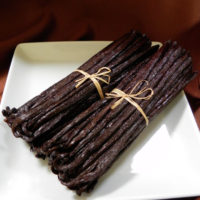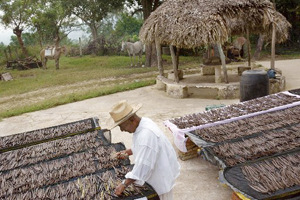I'm amazed at how superior your vanilla is!
– Des, The Grommet
$270.00 – $450.00
Fairly traded and sustainably grown in Tahiti without chemical pesticides or fertilizers.
Non-GMO and gluten-free.
Available by special order only. Please inquire via email for pricing and current availability.
Tahitian vanilla (Vanilla tahitensis) comes from Vanilla planifolia stock crossed with Vanilla odorata. It is classified as a separate species, as it is considerably different from planifolia in both appearance and flavor.
Tahitian vanilla beans are generally shorter and plumper, and have a higher moisture content than planifolia beans. They have a thinner skin and fewer seeds than planifolia beans and are less shiny. Tahitian vanilla has a fruity, floral aroma with notes of licorice, cherry, prunes and redolent of fresh fruit as you would find in Viognier or Reisling wine.
True Tahitian beans are perfect to use in any cream desserts such as Creme Brulee, vanilla pastry cream, or custards. They are ideal in any fruit desserts, baked or fresh. Tahitians use them in seafood dishes — for instance, Mahi Mahi in a vanilla cream sauce, or Seafood in a Coconut Milk and Rum Sauce. The unique flavor of Tahitian vanilla can make for a stunning presentation in vanilla sugar cookies and delicate vanilla cakes.
True Tahitian vanilla beans are grown in Tahiti. You will find less expensive vanilla beans labeled as Tahitian that are not true Tahitian beans, but are Vanilla tahitensis beans, usually grown in Papua New Guinea. These beans will have a similar fruity and floral flavor and fragrance profile, but will not be as plump and moist, and not quite as flavorful as true Tahitian beans.
There are approximately 70 to 80 beans per pound. Average length of beans is 12cm (approx. 4.7 inches).
Vanilla beans will keep indefinitely in an airtight container, in a cool, dark place. Keep the beans in the heavy plastic packaging they’re shipped in. You can then put the beans and packaging in a glass or plastic container with a good, tight seal. (A large mason jar works well.) If you live in an area that is both hot and humid, the beans can be stored in a glass jar without the plastic packaging. Beans are most comfortable when the temperature ranges from 60 degrees F (15.5 C) to 85 degrees F (29 C). Do not refrigerate or freeze vanilla beans, as this can cause them to dry out and harden.
| Weight | 1.2 lbs |
|---|---|
| Dimensions | 8 × 5 × 1.5 in |
| Select Size | 1/4 lb., 1/2 lb., 1 lb. |

PLEASE CLICK HERE FOR INFO ON COVID-19 ITEM AVAILABILITY & SHIPPING DELAYS
I was given a small bottle of Rain’s Choice in a gift basket and I have been hooked ever since. The flavor makes all of my baking so much better! I will never use grocery store vanilla again!


© 2021. All Rights Reserved
Designed/Developed by Kat & Mouse
Reviews
There are no reviews yet.